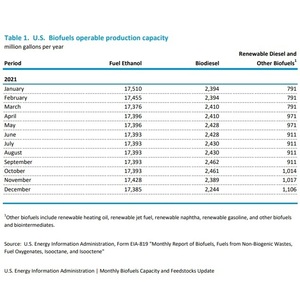EIA: Biofuel capacity down in December, feedstock use up

March 1, 2022
BY Erin Krueger
Total U.S. operatable biofuels production capacity fell slightly in December to 20.834 billion gallons per year, according to data released by the U.S. Energy Information Administration on Feb. 28. Feedstock use was up for the month.
Fuel ethanol production capacity fell to 17.385 billion gallons, down 43 MMgy when compared to the 17.428 billion gallons of capacity in place in November. Biodiesel production capacity was also down, falling to 2.244 billion gallons, a reduction of 145 MMgy when compared to the 2.389 billion gallons of capacity reported for November. Production capacity for renewable diesel and other biofuels, which includes renewable heating oil, renewable jet fuel, renewable naphtha, renewable gasoline and other biofuels and biointermediates, increased to 1.106 billion gallons in December, up 89 MMgy when compared to the 1.017 billion gallons of capacity reported for November.
U.S. biofuel producers consumed 28.938 billion pounds of feedstock in December, up from 28.083 billion pounds in November.
Advertisement
Advertisement
Approximately 26.761 billion pounds of corn went to biofuels production in December, up from 26.145 billion pounds in November. An additional 153 million pounds of grain sorghum was used to produce biofuels in December, down slightly from 155 million pounds the previous month.
According to the EIA, 937 million pounds of soybean oil went to biofuels production in December, up from 818 million pounds in November. The use of corn oil was also up, reaching 301 million pounds, compared to 244 million pounds the previous month. Canola oil consumption was down, falling to 126 million pounds in December, down from 133 million pounds in November.
Advertisement
Advertisement
Biofuel producers consumed 368 million pounds of yellow grease, 160 million pounds of beef tallow, 51 million pounds of white grease and 20 pounds of poultry fat in December, compared to 347 million pounds, 112 million pounds, 49 million pounds, and 17 million pounds, respectively, in November.
The EIA also reported that 61 million pounds of recycled feeds and wastes classified as “other” went to biofuel production in December, compared to 63 million pounds the previous month. The agency withheld data on “other” waste oils, fats and greases; “other” vegetable oils; yard and food waste; and other biofuel feedstocks not elsewhere specified or identified consumed in December in order to avoid disclosure of individual company data.
Additional data is available on the EIA website.
Related Stories
The USDA significantly increased its estimate for 2025-’26 soybean oil use in biofuel production in its latest World Agricultural Supply and Demand Estimates report, released July 11. The outlook for soybean production was revised down.
The U.S. Energy Information Administration maintained its forecast for 2025 and 2026 biodiesel, renewable diesel and sustainable aviation fuel (SAF) production in its latest Short-Term Energy Outlook, released July 8.
XCF Global Inc. on July 10 shared its strategic plan to invest close to $1 billion in developing a network of SAF production facilities, expanding its U.S. footprint, and advancing its international growth strategy.
U.S. fuel ethanol capacity fell slightly in April, while biodiesel and renewable diesel capacity held steady, according to data released by the U.S. EIA on June 30. Feedstock consumption was down when compared to the previous month.
XCF Global Inc. on July 8 provided a production update on its flagship New Rise Reno facility, underscoring that the plant has successfully produced SAF, renewable diesel, and renewable naphtha during its initial ramp-up.
Upcoming Events










